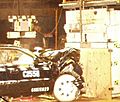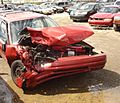Crumple zone facts for kids
Crumple zones are special parts of a car designed to keep you safer during a crash. When a car hits something hard, like another vehicle or a wall, these zones are built to crumple up in a controlled way. This crumpling helps to absorb the energy from the impact, slowing down the crash over a longer time. By doing this, crumple zones reduce the strong force that would otherwise hit the people inside the car, making the crash less dangerous.
Contents
What are Crumple Zones?
Crumple zones are areas in a vehicle, usually at the front and back, that are designed to deform and collapse during a collision. Think of them like a shock absorber for a car crash. Instead of the car staying rigid and stopping suddenly, these zones fold and crush. This controlled deformation helps to protect the passengers.
How Do Crumple Zones Work?
When a car crashes, a lot of energy is released very quickly. Crumple zones work by absorbing this energy. They do this by changing their shape, which takes time and effort. This process helps to:
- Increase crash time: By crumpling, the car takes a little longer to come to a complete stop. Even a tiny fraction of a second can make a huge difference.
- Reduce crash force: Spreading the impact over a longer time means the force on the car's occupants is much lower. This is like falling onto a soft mat instead of a hard floor.
- Protect the passenger cabin: The goal is to keep the main part of the car, where people sit, as intact and safe as possible. The crumple zones sacrifice themselves to protect you.
Why Are Crumple Zones Important?
Without crumple zones, the car would stop almost instantly in a serious crash. This sudden stop would transfer all the crash energy directly to the people inside. This would cause very severe injuries. Crumple zones are a key safety feature that helps save lives and reduce injuries in car accidents. They are a vital part of modern vehicle safety design.
History of Crumple Zones
The idea of crumple zones isn't new! The concept was first developed by Béla Barényi, an engineer who worked for Mercedes-Benz in the 1950s. He patented the idea of a car body with rigid passenger compartments and deformable front and rear sections.
Who Invented Crumple Zones?
Béla Barényi received a patent for his "safety cell" design in 1952. His work laid the foundation for how cars are designed for safety today. His ideas were first put into production cars by Mercedes-Benz in the late 1950s and early 1960s. This was a major step forward in making cars much safer for everyone.
Crumple Zones in Different Vehicles
While we often think of crumple zones in cars, the idea of absorbing crash energy is used in other vehicles too. For example, some modern trains have crushable sections at their ends. These work similarly to car crumple zones, helping to protect passengers and the train driver during a collision. The basic principle is the same: control how the vehicle deforms to manage crash energy.
Images for kids
-
A crash test illustrates how a crumple zone absorbs energy from an impact.
-
Road Maintenance Truck Impact Attenuator, Auckland, New Zealand
-
Cross section to show the different strength of the metal in a Saab 9000. The safety cell is in stronger metal (red) compared to the crumple zones (yellow).
-
Mazda 121 (re-badged Ford Fiesta) crash test car from the British Transport Research Laboratory.
-
A Toyota Camry after a front impact with a tree. Airbags were deployed.
-
VW Polo first successful frontal full car crash simulation (ESI 1986).
-
Visualisation of how a car deforms in an asymmetrical crash using finite element analysis.
-
Euro NCAP FRONTAL IMPACT (left-hand drive vehicles).
-
Lotus Evora front crash test showing Aluminium chassis crush structure, the height of the rigid front chassis side beams and rigid front cross beam.

















